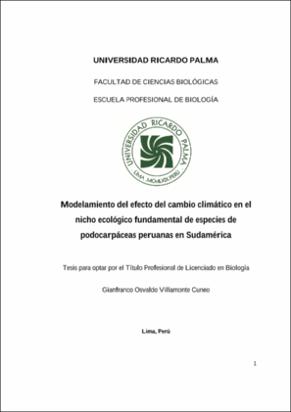“Modelamiento del efecto del cambio climático en el nicho ecológico fundamental de especies de podocarpáceas peruanas en Sudamérica.“
Fecha
2018-07-16Autor
Villamonte Cuneo, Gianfranco Oswaldo
Metadatos
Mostrar el registro completo del ítemResumen
La presente investigación busca modelar el efecto del Cambio Climático en el nicho
ecológico fundamental (área ambientalmente adeucada) de las 10 especies de
podocarpáceas que habitan el Perú, las cuales persisten en bosques relictuales,
enfrentando múltiples amenazas de origen antrópico. Para esto, se elaboraron modelos
de nicho ecológico en el software Maxent, empleando datos de ocurrencias de estas
especies y condiciones ambientales (temperatura, precipitación y tipo de suelo) entre
1950 y 2000. Los modelos resultantes fueron proyectados de acuerdo a las condiciones
climáticas estimadas para los años 2050 y 2070 según los escenarios RCP 2.6 y 8.5
(menor y mayor efecto del Cambio Climático) para el modelo climático HADGEM2-
ES. Estos modelos y proyecciones se transformaron en mapas binarios de
presencia/ausencia que permitieron analizar la variación espacio-temporal de estas
especies. Los mapas obtenidos evidencian una tendencia de las áreas ambientalmente
apropiadas de las podocarpáceas peruanas a migrar hacia mayor altitud, reduciendo su
extensión dentro y fuera de áreas protegidas del SINANPE (Sistema Nacional de Áreas
Naturales Protegidas por el Estado). No obstante, de acuerdo al modelamiento
realizado, se espera que estas persistan al menos hasta el 2070, incluso en el escenario
climático más extremo (RCP 8.5), en las áreas protegidas del Perú en las que se ha
confirmado su presencia y que actualmente concentran su mayor riqueza específica.
The present research focuses on modelling the effect of Climate Change on the
fundamental ecological niche (environmentally adequate área) of the 10 species of
podocarps that inhabit Peru, which persist in relictual forests, facing multiple
anthropogenic threats. For this purpose, ecological niche models were performed in
Maxent software, using these species ocurrence and environmental data (temperature,
precipitation and soil type) between 1950 and 2000. The resulting models were
projected according to the climatic conditions estimated by RCP 2.6 and 8.5 scenarios
(lesser and greater effect of Climate Change) of HADGEM2-ES climate model for the
years 2050 and 2070. These models and projections were transformed into binary
presence / absence maps that allowed the analysis of the spatio-temporal variation of
these species. These maps show a tendency of the environmentally adequate areas of
the Peruvian podocarps to migrate towards greater altitude, reducing their extension
inside and outside protected areas of SINANPE (National System of Natural Protected
Areas by the State). However, according to these results, it is expected that these
species will persist at least until 2070, even in the most extreme climate scenario (RCP
8.5), in the protected areas of Peru where their presence has been confirmed and which
currently concentrate their greatest specific richness.
Colecciones
- Biología [176]


